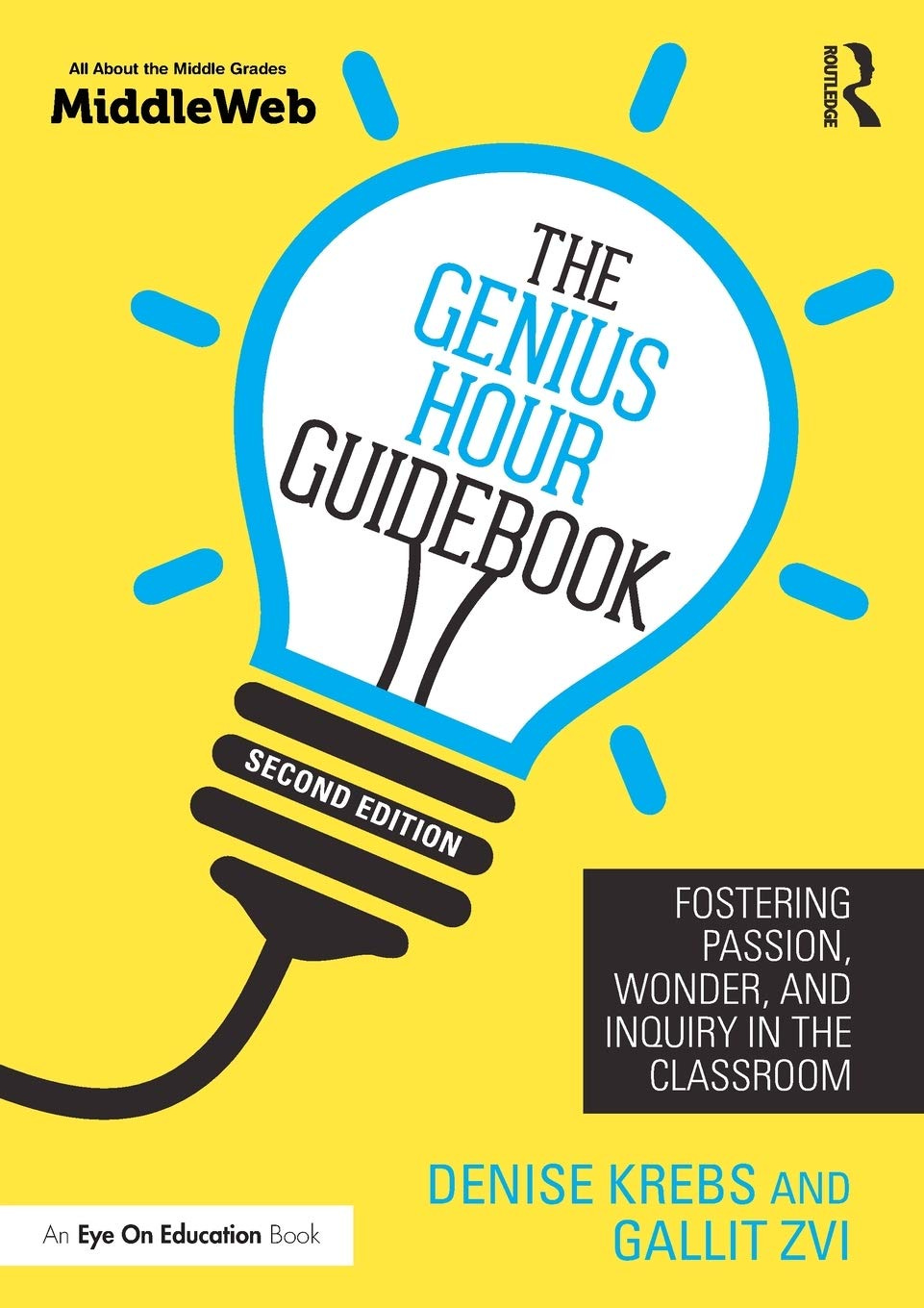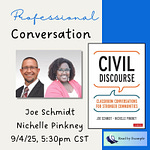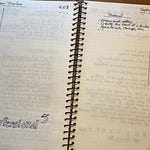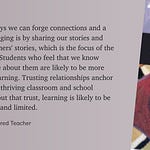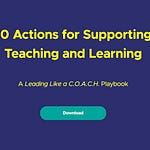What world are we preparing our students for? The future is difficult to predict, yet we are confident that a capacity for lifelong learning, including a willingness to take risks and make mistakes, will be essential.
One approach to developing fearless learners is described in The Genius Hour Guidebook: Fostering Passion, Wonder, and Inquiry in the Classroom by Denise Krebs and Gallit Zvi. Both classroom teachers, Denise and Gallit share their experience in supporting students’ ideas and independence, including:
the importance of first building trust and community,
how Genius Hour can foster critical thinking, and
favorite picture books for inspiring readers and learners.
Enjoy this site but not subscribed? Sign up today - most content is free.
Related Resources
A Middleweb article by Denise and Gallit about genius hour for remote learners
My experience (here and here) using genius hour with my own children
Every podcast episode on Apple (if you can, leave a rating!)
Share this episode with a colleague.
Full Transcript
Matt Renwick:
Welcome Gallit and Denise, thank you for talking with me today. You are both practicing teachers, correct?
Gallit Zvi:
Yeah. Well, I'm on maternity leave right now, but until I had my baby, I was.
Matt Renwick:
Congratulations.
Gallit Zvi:
Thanks.
Matt Renwick:
And where are you specifically located?
Gallit Zvi:
So I am in Surrey, British Columbia, Canada. So a suburb of Vancouver. Wonderful school district up here in BC.
Denise Krebs:
And right now I'm located in Bahrain teaching in a bilingual school, Arabic and English speaking school.
Matt Renwick:
And just with your classroom work, the first edition of your book, The Genius Hour Guidebook was born out of your work in the classroom, as well as networking with other educators online. And I think this was how I came across the first version of your book on Twitter. And at that same time, my wife was teaching second grade and she had a few students with some significant needs, especially around behavior. I suggested The Genius Hour Guidebook and its apprentice for her at the end of the school day, as part of her action research project. She implemented it and the results were impressive. For one student, their behaviors were reduced by 70%, seven, zero since implementing Genius Hour.
Matt Renwick:
And when she asked kids what made the difference, they noted that they just wanted to think at the end of the day. Your second edition of the book is out now and I wanted to make other educators aware of the power of Genius Hour in the classroom. And so with that, there's certainly more to it than just wanting to tinker, but what is Genius Hour and why should teachers incorporate it into their classrooms?
Denise Krebs:
Yeah, I'll go. It is tinkering as part of it, but it's a time in the school week when students are given autonomy, they're empowered to do their own learning. They get to choose what they want to learn at the time when teachers get out of the way and let them learn purposefully. That's why those second graders felt empowered. They didn't want to misbehave because they were entrusted to wonder, to learn, to create, to do research, to take action, to produce things they can spend time mastering. They choose the learning adventure. So, we think they become fearless learners. They make learning visible then by sharing their projects or what they've been doing and the process. So a lot of times with a larger global audience or just at their school level or with people. It's hard to just put it in a few words, but Gallit, do you want to add anything?
Matt Renwick:
That's good.
Gallit Zvi:
I think the short version of it for me always is it's passion-based and inquiry-based learning smushed together.
Matt Renwick:
And you mentioned too, trust. That you're trusting the kids to use this time for their own passions and interests. And I believe at some point it was mentioned Genius Hour should be proceeded with building community and relationships. And how did teachers know when kids are ready for self-directed learning?
Gallit Zvi:
Good question. So, we talk about that early in the book where we talk about how for us, we don't start a Genius Hour project with a new class until we've spent some time building community in the classroom. And so how do when you build that community? I guess it's just a feeling you have, it's hard to say that X, Y, and Z has to happen before for you go, but for me, if I have a new class of students, I generally spend the first few months working on building community. So having classroom meetings, going outside and doing leadership challenges, playing games together, just spending that time, getting to know each other and building that trust before we say, "Hey, we want you to do something that can be a little bit risky, to take the chance and work on a project and share the obstacles you're facing with the rest of the class."
Gallit Zvi:
That's some vulnerable work that they're taking on. And so we want them to have that sense of community first. So I thought about this before. I don't know that this happens and then you know you've built it. It's more of that feeling you get where you know that there's some trust here, the kids are getting along well, there's a sense of community. And so for me, our school year goes September to June. So generally I would spend September, October, November, and then not really bothered starting in December because we're only there for half the month. So usually a Genius Hour, we would start when we come back in January after winter break.
Gallit Zvi:
But that being said, I've also had the pleasure of teaching the same students for two or three years in a row. And so if I have the same group of kids or mostly the same group of kids, we usually start way earlier then, because they already know what it's all about and they're eager to start. They don't want to wait until term two. They're ready to go. But I guess you as a teacher, every class is going to be different. And so you get that feeling with your kids when you know that.
Matt Renwick:
You can tell when the kids are already by that level of trust between each other and among each other too, because you're asking them to make mistakes and try new things.
Gallit Zvi:
Yeah.
Matt Renwick:
I like this quote you included in the book, it's from Alan November, from his book that I've also read and enjoyed, Who Owns the Learning. He said, "If we teach one skill to prepare our students to survive in a web based world, it should be that of critical thinking and the analysis of online information." Survive is a strong word. And I would agree with that verb choice. How does Genius Hour strengthen critical thinking with students?
Denise Krebs:
Yeah. We know these last few years in America, especially navigating online information, misinformation, disinformation, it is so critical. It is a matter of survival, isn't it? We have people who are believing conspiracy theories and going doing crazy things. So critical thinking is a key to healthy living and healthy choices to make needed changes in the world. We have to have critical thinkers. And of course, Genius Hour is no panacea for that, but it is a step. It's one step in a process of students learning to trust themselves, to solve their own learning dilemmas, to make good choices and have a mentor facilitator teacher with them as they do it. So, yeah, it can happen and talking about that quote was about online, but, but yeah we have to teach critical thinking.
Matt Renwick:
And speaking of online information or any information, I love that you devoted an entire chapter to picture books, then inspire kids to engage in Genius Hour. This is a literacy leadership site, any titles in particular that you would highly recommend for any classroom K-12
Gallit Zvi:
Yeah. We love picture books there. They're our favorite. We love them so much. So in the book we talk about 16 different titles. There's way more of the course that you could use for Genius Hour. And so I was thinking about that, like which one would be the one go-to one and it's so hard to pick because there's so many wonderful picture books out there. And I totally believe in using picture books all the way up to any grade level when I taught education students at university, we use picture books there too. So, definitely encourage the use of picture books for all grades. I think the one I've used the most is called, The Most Magnificent Thing with a little girl that is working on her own project, trying to create the most magnificent thing. So she's is a little maker and she gets quite in the book when things don't go right.
Gallit Zvi:
And this little project falls apart. And so that's the one I've probably used the most in class to teach persistence and I'm sticking to it. She gets quite frustrated, but she goes for a walk and takes a break, takes a breather from her project and then comes back at it with fresh eyes. And so we have a good conversation with the kids around that book because a lot of them do get frustrated. They've chosen a topic or an inquiry question and they go at it, and then part way through, they're like, "No, I want to quit. This is stupid. It's not working. I can't do it." And so just going back to those character traits that we learned from the picture books and talking about what that little girl did in The Most Magnificent Things. So that for me as a personal favorite, I really like that one. But goodness, there's so many. Rosie Revere, Engineer, Anything by Peter Reynolds. There's so many good choices.
Denise Krebs:
Yeah. My favorites are The Dot and The Word Collector by Peter H. Reynolds.
Matt Renwick:
I think I brought several of those home with my own kids based on that list, I was at the public library and checking out those books and just made them available to read on their own and get some inspiration. So it's a very helpful curated list. Thinking broader with a crowded curriculum and even greater constraints with the pandemic, how can leaders convince or persuade teachers at least to incorporate Genius Hour as part of their day?
Denise Krebs:
I love the way you worded that question actually, because I feel like teachers, if they know about it and want to do it, they just want permission. So if a leader is willing to let them try, then I think they're going to jump all over that. But you're right that curriculum is crazy. We went from... I only had seven periods of English in fifth grade. We went down to two in the pandemic. So, how do you even begin to teach? We're not teaching the curriculum really, anyway? We can't make even justice of it, but I did do Genius Hour last spring. And it was just such a fresh air for the learning environment. The kids were so happy and it was just out of the routine and they were just at home working, so they had all their supplies handy and they made the messes at home. It was easier for me too, that they did art and cooked and learned music and languages and played and sang. And it was just beautiful.
Denise Krebs:
And not only that, they were doing English curriculum, because we're a bilingual school. These are second language learners. So they were defending their proposals, they were doing these beautiful presentations on Flipgrid and giving good feedback to each other. So much English language going on as well. And I think if the leaders are willing to let them do it, it is a beautiful, healthy way to spend some of this pandemic curriculum. And we can still find... We're always finding curriculum ties. It is curriculum. Giving them permission to learn on their own.
Matt Renwick:
You bring up a good point that you don't have to separate Genius Hour from the rest of it. It can be a part of it and really an independent opportunity to apply those skills. And you list quite a few standards in the book and how this applies really in any subject area. What is one thing you would recommend to a teacher new to Genius Hour and wanting to give it a try and experience initial success?
Gallit Zvi:
My gut reaction is to say, you just do it. That's the one thing. Just don't be scared and just give it a try. You can reflect afterwards as we do on any lesson or unit that we teach. Reflect afterwards and say, "Okay, what could I do to make it better next year or next term?" But give it a go. Don't be afraid, it's my first reaction. And then the second one would be, okay, now slow down and take your time with it. Really introduce it properly, read the picture books, watch the inspiring videos, do your own Genius Hour project and share it with the kids, and then let them go and then just have fun and see where they end up and you'll learn along the way. And then at the end reflect and just figure out, okay, what can we do differently next year to make it better?
Gallit Zvi:
I know the first Genius Hour project we did in our classes, that was quite a few years ago, Denise. I don't remember the year, but it was... I don't know. It was a long time ago.
Denise Krebs:
10 years ago.
Gallit Zvi:
No, 10 years ago. Yeah. And the way I do it now is a little bit differently than the way I did it then. It's like, you learn as you go each time and make little tweaks and changes and improvements to make it better suit yourself and your current group of kids too. It's different depending on your class. But yeah, I guess number one tip, just do it, just go for it, have fun, jump in, don't be scared, and part B to that is now that you've just jumped in, slow down a bit and take the time to properly introduce it. You don't need to jump right to doing projects. Get excited first, get inspired, brainstorm, do all those steps first that we talk about in the book.
Matt Renwick:
And the idea of the teacher doing a Genius Hour project in front of the kids and the kids seeing the teacher excited about a personal project, it has to be impactful for the kids, right? Well, thank you, Gallit and Denise, the book is The Genius Hour Guidebook, it's in its second edition, which always means a lot of teachers got their hands on the first edition. And so there's a lot. I've read both editions, there are more information in this current version and I would highly recommend it for any teacher, any grade level. So thank you for putting this out in the world and good luck with you and the rest of the school year.
Denise Krebs:
Thank you, Matt.
Gallit Zvi:
Thank you, Matt.


